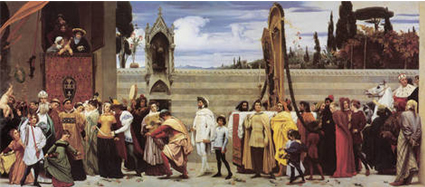The Leighton blockbuster at the Royal Academy presents one view of an eminent painter loved by the establishment in his time. But does his work really merit this adulation?
Frederic, Lord Leighton, the only British artist ever to have been elevated to the peerage, always did have a weakness for the high- and-mighty title. The first painting he ever exhibited in London was a vision of the past to which young Fred (taking a deep breath) attached the following impressive-sounding mouthful: Cimabue's Celebrated Madonna is Carried in Procession through the Streets of Florence; in front of the Madonna, and crowned with laurels, walks Cimabue himself, with his pupil Giotto; behind it Arnolfo di Lapo, Gaddo Gaddi, Andrea Tafi, Niccolo Pisano, Buffalmaco, and Simeone Memmi; in the corner Dante. Whatever his other talents, it was clear from the outset that conciseness was not one of them.
Cimabue's Celebrated Madonna is Carried in Procession, etcetera is as list-like and as listless a painting as its title suggests: an inordinately industrious High Victorian exercise in painstakingly inaccurate historical reconstruction. The celebrated Florentine painting that Leighton's painting celebrates was not, in fact, painted by Cimabue in Florence but by Duccio in Siena. Luckily, no one noticed at the time. In fact, nothing could matter lessbecause getting it right was not really Leighton's aim, and criticising him for inaccuracy would be like criticising Liberace for vulgarity. Leighton spent his life purveying soothing inaccuracies to the type of Victorian patron who liked nothing better than an art that extolled the joys of living somewhere, anywhere, but in the present. In Leighton's imaginary Florence, there is a great poet on every street corner, all are immaculately well dressed and everyone, from the oldest pontiff to the tiniest baby, is forever falling into poses of wondrously picturesque Old...


